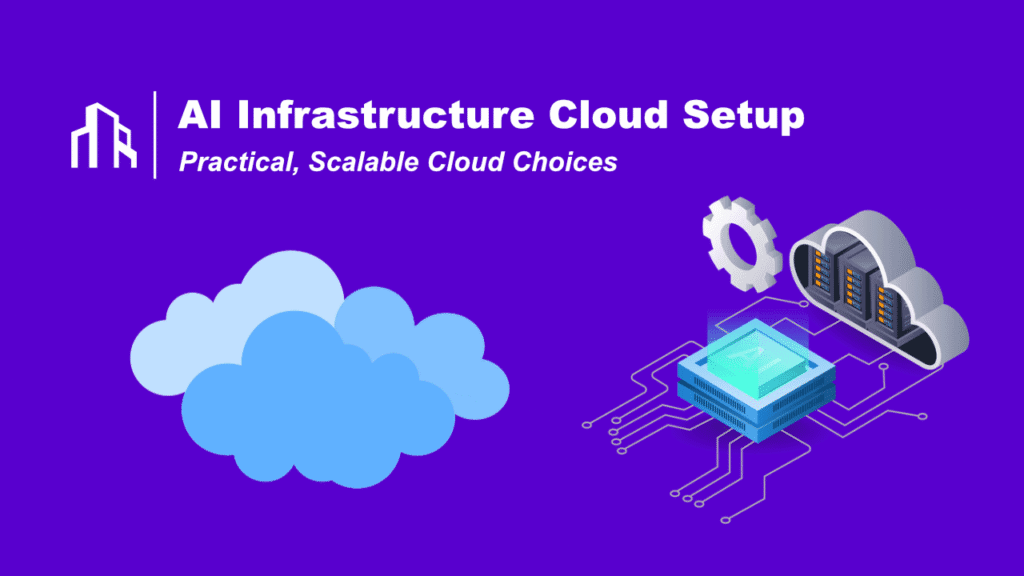
Designing AI infrastructure is no longer just “pick a GPU and go.” You need secure networking, a serving stack for inference, a data layer with governance, and an MLOps toolchain that won’t buckle at scale. This guide outlines the core decisions, compares viable cloud options, and proposes reference architectures that balance cost, control, and compliance.
What “good” AI infrastructure looks like
A production-ready setup covers:
- Model access and hosting: managed foundation models or self-hosted open models
- Secure networking: private connectivity, VPC endpoints, and least-privilege IAM
- Serving: high-throughput inference servers and autoscaling
- Observability: latency, cost, drift, safety events
- Data governance: encryption, lineage, retention, and policy enforcement
- MLOps: experiment tracking, CI/CD, canary rollouts, and rollback paths
Hyperscalers vs specialist GPU clouds
Hyperscalers (AWS, Google Cloud, Azure) offer first-party model services, enterprise networking, and deep integration with identity, storage, and security. Example advantages:
- Private access to model endpoints within your network, keeping traffic off the public internet.
- First-party agent and safety stacks such as Bedrock AgentCore and Azure AI Content Safety to implement guardrails.
- Managed model catalogs like Google Vertex AI with variants optimized for reasoning or cost-sensitive workloads.
Specialist GPU clouds (RunPod, CoreWeave, Lambda, Paperspace) excel when you want maximum control per dollar and direct access to GPUs for open-weight models or custom fine-tuning. They often undercut on-demand hyperscaler GPU pricing and let you bring your own containers and serving stack.

RunPod.io
On-demand GPU cloud for deploying LLMs, AI agents, and custom workloads. RunPod offers flexible scaling, lower costs, and full control over your AI infrastructure.
- ✓ GPU-as-a-service with enterprise performance
- ✓ Deploy Hugging Face, custom models, or APIs
- ✓ Scale workloads up or down instantly
Also See: Deploying Hugging Face LLMs on RunPod
Reality check on GPU costs
Owning high-end hardware is capital intensive. An H100 80 GB typically lists at tens of thousands of dollars per card; full DGX nodes run in the hundreds of thousands before support. On-demand cloud rentals usually fall in the high single-digit dollars per GPU-hour depending on region and commitment.
Reference architectures
1) Managed-model, private network path
Best when you need fast time-to-value and strict data boundaries without managing model runtimes.
- Models: Bedrock, Vertex AI, or Azure AI models
- Network: VPC-only access with private endpoints
- Serving: Provider-managed endpoints and autoscaling
- Safety: Built-in content safety filters and policy checks
- Observability: Cloud-native logging, tracing, analytics
Why it works: you inherit enterprise networking and guardrails while avoiding runtime patching and CUDA headaches.
2) Self-hosted open models on specialist GPU cloud
Best when you need custom models, tight cost control, or performance tuning.
- Compute: RunPod or similar with container images preloaded for vLLM or Triton
- Serving: vLLM for high-throughput text generation or NVIDIA Triton / TensorRT-LLM for latency-sensitive paths
- Network: Private endpoints and IP allow-lists, VPN or peering back to your core VPC
- Data: Object storage plus vector DB hosted in your network
- Observability: Prometheus metrics, OpenTelemetry traces, cost per token dashboards
Why it works: you control kernels, libraries, scheduling, and can mix GPU tiers to match load profiles.
3) Hybrid control plane
Best when you want managed safety and governance but keep workloads portable.
- Control plane in a hyperscaler for identity, safety filters, workflow orchestration
- Data plane spans managed endpoints and self-hosted GPU pools
- Routing uses policy to send tasks to the most cost-effective or compliant target
Benefit: you keep options open as model prices and capabilities shift over time.
Decision framework
- Workload shape
- Latency-critical chat and agents → high-throughput serving, kernel-level optimizations
- Batch summarization and RAG jobs → cheaper GPUs or spot with queue-based autoscaling
- Data sensitivity
- Regulated data or hard privacy mandates → private endpoints, customer-managed keys, audit trails
- Public or synthetic data → wider provider choices and preemptible capacity
- Model strategy
- Proprietary managed models for reliability and speed to market
- Open-weight models for control, custom fine-tuning, and IP portability
- Cost posture
- Opex-only startup mode → on-demand with aggressive autoscale
- Steady state scale → committed use, reserved capacity, or a mix of on-demand plus specialist GPU clouds
Concrete building blocks
- Serving layer: vLLM for token-throughput, NVIDIA Triton and TensorRT-LLM for latency and GPU efficiency
- Retrieval: vector database of choice behind a private service; cache hot embeddings
- Pipelines: event-driven queues for batch jobs, serverless orchestrators for agents
- Networking: VPC peering or Transit Gateway for multi-VPC topologies and clean segmentation
- Safety and policy: native content-safety services where available; add jailbreak and PII detection in the request path
Cost and scale notes
- Treat $/token as the unit of economics. Track tokens in, tokens out, and GPU-hour per 1k tokens served.
- H100-class performance helps with long-context and complex reasoning but is expensive; mix in L40S or A100 for batch or background workloads when acceptable.
- If you consider on-prem, price the full stack: chassis, networking, cooling, spares, and support. DGX-class nodes exceed many mid-market budgets before you hire ops.
Recommended setups by maturity
Pilot
- Managed models on Bedrock, Vertex, or Azure AI with private access
- Minimal custom code, strong observability, safety filters on by default
Production v1
- Add a dedicated inference cluster using vLLM or Triton on specialist GPU cloud for one high-volume workload
- Keep sensitive data behind private endpoints and customer-managed keys
Scale-out
- Introduce policy-based routing across providers
- Commit to reserved capacity plus a burst pool of on-demand GPUs
- Continuous evaluation to swap models as new releases shift price-performance
Key takeaways
- If you need speed and governance, start with managed models over private network.
- If you need control and cost efficiency, self-host open models on specialist GPU clouds.
- Expect rapid change. Keep a hybrid option ready so you can re-route workloads as models, prices, and features evolve.
Want a tailored reference architecture for your stack including IAM policies, VPC diagrams, serving topology, and cost dashboards?
Contact Scalevise and we will blueprint your AI infrastructure with a pragmatic path to production.


